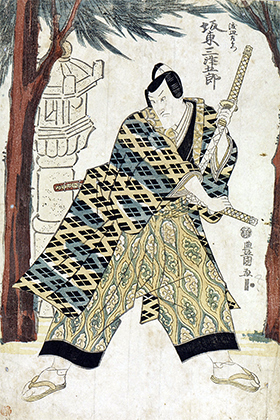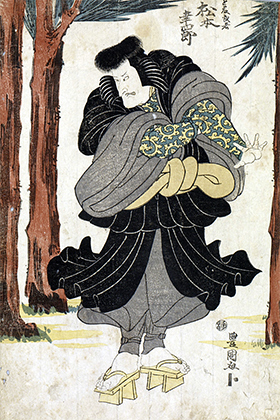| MISAO NO HANA TOBA NO KOIZUKA |
| Play title | Misao no Hana Toba no Koizuka Taso ya Taso na Ute no Adamono |
| Common title | Kesa to Morit˘ |
| Authors | Katsu Hy˘z˘ I, Sakurada Jisuke II, Shimizu Sh˘shichi I |
| History |
Katsu Hy˘z˘ I and Sakurada Jisuke II drama "Misao no Hana Toba no Koizuka" was premiered in the 11th lunar month of 1809 at the Ichimuraza [casting]. It was a kaomise drama, which celebrated the shűmei of Onoe Sh˘roku I and Onoe Matsusuke II. A Tokiwazu-based dance-drama entitled "Taso ya Taso na Ute no Adamono", was staged within this kaomise drama. In modern times, it was revived twice at the National Theatre, in November 1980 and October 2005. |
| Structure |
The revival at the National Theatre in November 1980 was in 4 acts (divided into 9 scenes). |
| Key words |
Chűnori Genji Goshirakawa Tenn˘ Heiji no Ran Heike Himanegi no Kiyomori Hi˘gi H˘gen no Ran Hotoke Gozen Itsukushima Jinja Jidaimono Jingoji Kaomise Koshimoto Kubi Jikken Minamoto Tameyoshi Minamoto Yoshitomo Mochihito-˘ Mongaku Sanshű Sanuki Send˘ Shigehito Shinn˘ Shiraby˘shi Sokushitsu Sutoku Tenn˘ Sutokuin Taira Kiyomori Taira Shigemori Taira Tokitada Takakura-no-Miya Takaosan Tokiwa Gozen Tokiwazu Torii Umezugawa |
| Summary |
Act I In 1156 during the H˘gen Rebellion, the leader of the Heike clan, the ruthless warrior Taira no Kiyomori, defeated and captured the former Emperor Sutoku who was supported by the eastern clans under the command of Minamoto no Tameyoshi. Again, in 1159 during the Heiji Rebellion, Kiyomori defeated the supreme leader of the Genji clan, Minamoto no Yoshitomo, the son of Minamoto no Tameyoshi, with whom, until then, he had been sharing the control of the country. To establish his position, Kiyomori has banished the ex-Emperor Sutoku to Matsuyama on the island of Shikoku and has established himself at the Itsukushima Shrine on the Inland Sea with grand manner and sumptuousness. At dead of night in a thicket of pine trees in the precincts of the Itsukushima Shrine, two men are fighting for an imperial decree from the former Emperor Goshirakawa. He has taken the tonsure, but is calling for the combined forces of the Genji to rise up against the Heike and overthrow them. The two men are End˘ Musha Morit˘, dressed as a monk, and Watanabe Saemon Wataru, also in disguise. Morit˘ manages to capture the precious document. The scene is set at the Itsukushima Shrine, with its vermilion torii shining under the sun, where Taira no Kiyomori, the supreme ruler of the Empire of Japan at the zenith of his power, has sought to create a paradise on earth tailored for himself and his ambition. Kiyomori is feasting and drinking surrounded by his favourite sokushitsu and shiraby˘shi that he has brought from Ky˘to. A further group of girls arrives including a woman named Hotoke Gozen. Kiyomori is entranced with her and makes advances but she rejects him angrily. In reality, she is none other than Tokiwa Gozen, the wife of Minamoto no Yoshitomo, and she has come at the Itsukushima Shrine to assassinate Kiyomori. She draws a knife but he easily avoids it and he strikes her down, laughing triumphantly. Noticing that the sun is beginning to set, Kiyomori loftily announces to all that it may not do so without his permission. Raising his fan (hi˘gi), he causes the sun to rise again in the sky [1]. All the gathered people are overawed by Kiyomori power and charisma. Act II Prince Takakura-no-Miya, the son of Emperor Goshirakawa, who is suspected by Kiyomori of assisting the Genji cause, is in hiding at the Jingoji Temple on Mt. Takao. Waiting on him is a girl, Kaoru, who is the daughter of Awa Minbu and the wife-to-be of Watanabe Saemon Wataru. However, Watanabe has recently become intimate with a shiraby˘shi named Kesa Gozen, who is also in attendance at the service of Taira no Shigemori. Rivals in love, the two girls are embarrassed at being in such close proximity to each other. Kesa Gozen's brother in law, Hasebe Ch˘bŕ Nobutsura, has been involved in the plot to overthrow the Heike by conveying the news of the Emperor Goshirakawa's edict to Genji clansmen throughout the country. Since he lost the precious document, however, he has been in hiding at the temple under an assumed name. Takakura-no-Miya is unaware of this, and he asks Kesa Gozen to take a treasured flute, named Semiore, to Nobutsura to encourage him. End˘ Musha Morit˘ and Watanabe Saemon Wataru arrive in quick succession. End˘ knows of Watanabe's relationship with Kesa Gozen but nevertheless makes advances to her. She is embarrassed and asks Watanabe to help her. Nobutsura appears and makes them marry. Defeated in love, End˘ announces that he is under orders of Taira no Tokitada and demands Takakura-no-Miya's head from Watanabe who is guarding the Prince. He forces Kesa Gozen to become one of Kiyomori's koshimoto. Watanabe is at a loss what to do but Kaoru, his former wife-to-be, appears and tells him to kill her and substitute her head for that of Takakura-no-Miya. Watanabe feels ashamed that he has betrayed her by marrying Kesa Gozen, but, because Takakura-no-Miya is in danger, he forces back his fears and prepares to sacrifice the girl. At that moment, however, Nobutsura throws a windbell at Kaoru, which scars her face, and so Kaoru's head cannot be used as a substitute. Nobutsura's plan is to have his sister-in-law Kesa Gozen substituted instead. The demand of Kiyomori was just a ruse by End˘. Alone in the garden, he makes advances to her. He tells her that he is in possession of the imperial edict lost by her brother-in-law Nobutsura. If she wants it, she must agree to marry him and also give him Watanabe's head. She agrees for her brother's sake, and promises to make Watanabe drunk that evening so that End˘ can cut off his head. Overjoyed, End˘ gives her the imperial edict, which she hands over safely to Nobutsura. On the steps of the Jingoji Temple, it is dark and the moon has not yet risen. Everything has gone according to plan and End˘ appears carrying Watanabe's head. Suddenly Watanabe, himself, appears! The two rivals in love are both surprised and in the moonlight, they examine the head (kubi jikken). It is Kesa Gozen's head. She has substituted herself for both Watanabe and Takakura-no-Miya. Overcome with grief and shame, the two men cut their hair and decide to take religious vows. End˘ becomes the monk Mongaku and Watanabe becomes the monk Jűgen. First and foremost, they will carry out the order from Takakura-no-Miya who has decided that the time is ripe to announce the details of the imperial edict to the Genji clans to overthrow the Heike. They set off without further ado. Act III In Ky˘to, on the Umezu River, a woman is working as a courtesan on the boats and floating restaurants. She is Matsuyoi no Jijű, formerly beloved of Emperor Sutoku and believed to be the most beautiful woman at court. A son, Prince Shigehito, was born, but immediately afterwards, the emperor was exiled to Matsuyama. Jijű, with her child, began working on the boats, hoping to find a way of joining the Emperor. Unfortunately for Jijű, the Heike warriors have set up barriers at all ports and crossroads and she has been unable to obtain the necessary pass to get to Matsuyama. A guest arrives. He is Monokawa no Kurando Mitsusada, son of a powerful Heike lieutenant. He is suspicious of her at first, but is late impressed by her sincerity. A boatman, the send˘ Tedori no Yojir˘, and a courtesan, Komatsu, come along. They have been in Shigemori's favor for some time and hope to see the end of Kiyomori's tyranny. They support Jijű's claim to be allowed to travel to Matsuyama and eventually Mitsusada gives her a pass. She hastens to leave. Act IV Jijű arrives at Matsuyama in the province of Sanuki [2] with a warrior named Takiguchi Yukie Tsunehisa, but he loses sight of her at the landing stage. Tired of searching for her he is set upon by a group of fishermen, who are supporters of Kiyomori. They fight. The former Emperor Sutoku, now named Sutokuin, in a reversal of fortunes, is languishing in a lonely hermitage. Humiliated and resentful of Kiyomori for sending him into exile he has tried to find peace in religion and the chanting of scriptures, but to no avail. Sutokuin has turned to necromancy, and instead of prayers, he intones spells and incantations to turn himself into a demon king. Jijű arrives with the Shigehito. Sutokuin recognizes her but ignores them, not wishing to be interrupted in his sorcery. Jijű breaks down and weeps. Tsunehisa arrives and tries to intercede. Under secret orders from Kiyomori, two warriors named Yaguri T˘nai and K˘no Banz˘ have been spying on the hermitage. They attempt to kidnap Shigehito. Tsunehisa can do nothing, but at that moment, a dagger comes flying through the air and pierces the child's neck. Jijű and Tsunehisa are amazed. Sutokuin appears. He declares that he has acquired magic powers and that he will return to Ky˘to to overthrow the usurper Taira no Kiyomori. The child was in his way and so he had to die. Having nothing left, Jijű throws herself into the sea. In a great rage, Sutokuin assumes the aspect of a demon and rises into the sky. Amidst great claps of thunder, he heads towards Ky˘to [3]. |
| Notes |
[1] This scene is called Himanegi no Kiyomori. [2] Matsuyama was in the province of Iyo, not Sanuki. Two provinces on Shikoku Island, far away from Edo which may explain this little geographical mistake by Katsu Hy˘z˘ I! [3] The last act ended with a spectacular chűnori in October 2005 at the National Theatre [illustration]. |
 |
 |
|
The actors Band˘ Mitsugor˘ III and Matsumoto K˘shir˘ V playing the roles of Watanabe Saemon and End˘ Morit˘ in the drama "Misao no Hana Toba no Koizuka", which was staged in the 11th lunar month of 1809 at the Ichimuraza (print made by Utagawa Toyokuni I) |
|
|
|
| Contact | Main | Top | Updates | Actors | Plays | Playwrights | Programs | Links | FAQ | Glossary | Chronology | Illustrations | Prints | Characters | Derivatives | Theaters | Coming soon | News |